By Claire Bacon, ACN, CNC
Welcome to October. Fresh, crisp air; beautiful falling leaves; and the annual pumpkin spice celebration. It’s everywhere — lattes, creamers, muffins, even your favorite scented candle. Cozy? Yes. Hormone-friendly and low-toxicity? Not so much. Let’s talk about your fall coffee habit. That PSL (pumpkin spice latte) from your home K-cup or local drive-thru might feel like the ultimate comfort, but is it really? If your health goals include balancing your hormones, burning fat, and eliminating toxins, it’s time for a reality check.

Here’s what’s really in that festive cup:
- Artificial pumpkin spice flavorings and sweeteners — unless you’re making it yourself, that “autumn magic” comes from chemicals, not actual pumpkin.
- Powdered creamers — loaded with emulsifiers, oxidized fats, and sometimes carrageenan (a gut irritant linked to IBS).
- Plastic-lined paper cups or pods — leaching microplastics, bisphenols, and phthalates.
- Caffeine — your adrenal glands’ personal riding crop. Every sip increases cortisol, telling your body to “hang onto fat” and keeping stress hormones high. Overdependence on coffee is literally just like whipping a sick race horse. How long can a sick horse go before dropping??
This topic is a timely reminder, because October is Breast Cancer Awareness Month. It’s a perfect time to remember that many of these chemicals are suspected endocrine disruptors or possible carcinogens. Your seemingly innocent latte is no longer just a cozy treat — it’s a subtle daily exposure to hormone-interfering chemicals.
Depending how you make your coffee, you could be making a healthy pick-me-up, or maybe a chemical $#!% storm. Let’s take a closer look at the toxins we might potentially ingest in a typical, conventionally-prepared coffee…

Top Toxins in Conventional Coffee
Single-Use Coffee Pod
Most single-use pods (whether flavored or not) contain:
- Polypropylene or polyethylene plastic shell (heat-stable plastic).
- Aluminum foil lid (can leach trace metals under heat/acid).
- Inner filter paper (may be bleached with chlorine compounds → trace dioxins).
- Coffee grounds (potential pesticide residues if non-organic; acrylamide forms during roasting).
- Styrene, BPA, BPS, phthalates, and melamine (from heated plastic parts in the pod and machine).
- Microplastics (from hot water passing through the pod).
- Acrylamide (formed naturally during high-heat roasting of coffee beans).
Top-selling Non-dairy Creamer
Typical powdered or liquid formulations that you might find in your break room contain:
- Hydrogenated or partially hydrogenated oils (trans fats and oxidized or rancid fats).
- Corn syrup solids or sugar (refined carbohydrates, may contain glyphosate).
- Sodium caseinate (a chemically treated milk protein).
- Mono- and diglycerides (emulsifiers).
- Artificial flavors (synthetic compounds like ethyl vanillin, acetoin, butyric acid esters).
- Carrageenan (in some liquid versions — inflammatory and linked to IBS).
- Artificial sweeteners (like sucralose, acesulfame K, or aspartame).
- Titanium dioxide (whitening agent).
Paper Cup with Plastic Lining, Topped with a Plastic Lid
Did you know? Most disposable coffee cups are lined with low-density polyethylene (LDPE) or sometimes PLA (polylactic acid). When hot liquids contact these linings:
- Microplastics can leach into the beverage.
- Additives in plastics (such as UV stabilizers, or plasticizers) may migrate.
- Formaldehyde, acetaldehyde, and acetone may off-gas from adhesives and inks used on the cup and lid.
- Heat and acidity of coffee can leach styrene and bisphenol chemicals (BPA, BPF, BPS).
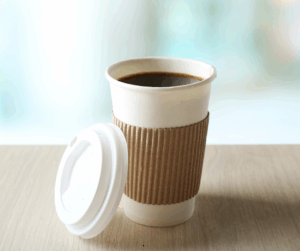
Summary of Chemical Exposures in Coffee
To sum it up, depending what you’re brewing, you could be ingesting:
| Toxin | Examples | Sources |
| Plasticizers & Bisphenols | BPA, BPS, phthalates (endocrine disruptors) | Pod plastic, cup lining, lid |
| Styrene compounds | Styrene monomer (possible carcinogen) | Cup lid (polystyrene) |
| Microplastics | Various chemicals | Pod plastic, cup lining |
| Heavy metals (trace) | Nickel, lead (possible carcinogen) | Pod foil, machine components |
| Volatile organic compounds (VOCs) | Acetaldehyde, formaldehyde (possible carcinogen) | Cup adhesives, inks |
| Synthetic flavoring agents | Ethyl vanillin, Acetoin, Cinnamaldehyde, Coumarin, Eugenol, Gamma-undecalactone, Methyl cinnamate, or Lactones | Non-dairy creamer |
| Processed fat byproducts | Oxidized lipids, trans fats (cell receptor disruptor) | Non-dairy creamer |
| Pesticide residues | Glyphosate, chlorpyrifos (possible carcinogen) | Non-organic coffee beans |
| Carrageenan | Ingredient linked to IBS (and possible carcinogen) | Non-dairy creamer |
And even more…
Acetone, Butyric acid esters, Mono- and diglycerides, Sodium caseinate, Corn syrup solids, Melamine, Aluminum, Artificial sweeteners (sucralose, acesulfame K, aspartame — depending on product), Titanium dioxide, Dioxins (from bleached filter paper), Additives in plastics (BHT, Irganox compounds), UV stabilizers from plastic linings, Adhesive chemicals (resins, formaldehyde-based glues), and Acrylamide.
Yuck!

What about Decaf?
Unfortunately, trying to be healthier by choosing Decaf doesn’t often work. That’s because chemical exposure can increase during decaffeination, depending on the method used. Solvent-based decaf (commonly using methylene chloride or ethyl acetate) may leave trace solvent residues, although it’s generally within FDA legal limits.
Are you old enough to remember the Sanka decaffeination scandal of the early 1970s? Decaf coffee at that time was commonly processed using trichloroethylene (TCE), an industrial solvent, which is also used in dry cleaning and metal degreasing. Lab testing found residues of TCE remaining in some brands of decaf owned by General Foods, namely Sanka. When news broke that a carcinogenic degreasing solvent was being used to remove caffeine from coffee beans, public outrage followed. As a result, TCE was banned for food use in the U.S. and Europe by the mid-1970s.
After that, manufacturers shifted to another solvent: methylene chloride (dichloromethane). Although it is less toxic than TCE, methylene chloride is classified as a potential human carcinogen and is restricted in some countries.
Swiss Water Process or CO₂ methods are cleaner, with no chemical residues. The Swiss Water process uses only water, temperature, and time. And CO₂ Decaffeination uses pressurized carbon dioxide, with no harsh solvents. Clean Decaf brands include: Verve, Purity, Simple Truth Organic, and True Beans.
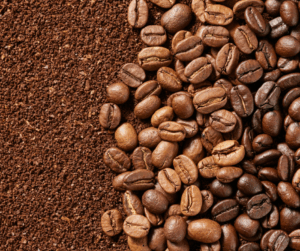
Why are all these chemical ingredients of concern?
Because collectively, they include potential allergens, solvent residues, microplastics, mucus membrane irritants, and liver toxicants. All of these things need to be dealt with by your liver, kidneys, and lymphatic system. These body parts are already under a lot of stress!
Yes, these chemicals are present at very low levels. But still… these levels are measurable, and potentially toxic if not fully neutralized and flushed out of the body on a regular basis. That’s why changing your daily coffee habit might just be the key to achieving your next level of health!
Not only that, but take a look at the Nutrition Facts listed on Starbucks’ website. You may be shocked to know, a Grande Pumpkin Spice Latte contains 390 calories and 52 grams of carbohydrates! That’s enough to throw off anyone’s macros for the day!
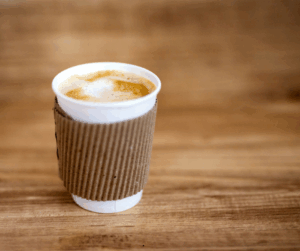
What will you do to clear all this toxicity?
I can tell you, when I return home from a trip where I had to drink conventional coffee on top of being exposed to fragrances, sanitizers, and more chemicals than I could shake a stick at, I can’t wait to kickstart my detox! Out of all the Cleanses I have done, the product that works best for me is SP Cleanse. It’s a blend of 20+ foods and herbs that promote liver, kidney, and lymphatic functions. It’s an awesome combo when put together with Diaplex, which helps to combat the onslaught of extra calories.
A few other great choices to consider…
MCS-2 from Biotics is a great choice for “Metabolic Clearing Support”. If you’ve been indulging in rich foods or exposed to toxins while traveling, MCS-2 provides Milk Thistle, Lycium berries, Cleavers, Burdock, and Red Clover – all for liver support. Plus, the addition of antioxidants and B vitamins help to round out this powerful detoxification supplement.
Livotrit Plus is an Ayurvedic (herbal) detoxification support. Provides Andrographis, Berberis Aristata, Boehavia, Eclipta, Indian Barberry, Indian Tinospora, Milk Thistle, Picrorhiza, Saccharum Officinarum, Sugarcane, and Tinospora Cordifolia to clear unwanted toxins from your system.
Nutriclear Chocolate Shake is a tasty way to work on your detoxification. Provides organic pea protein, medium chain triglycerides, fiber, and antioxidants with fruit and vegetable extracts to support safe and effective detoxification.
And of course, I can’t wait to get back to having my clean, organic coffee in my French Press!
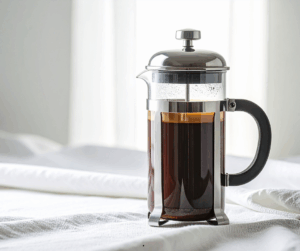
The PSL Coffee Solution
Now, if you’ve read this far, you might be alarmed. Does this mean you have to give up your PSL/Fall flavors completely? Nooooooooooo!!!! (I can hear you screaming already).
Not at all. You can still indulge, but smart substitutions may make all the difference:
- Brew organic, mold-free coffee such as Lifeboost, Purity Dark Roast, Bulletproof, or Forefront Health Thyro-Boost coffee.
- Brew in a French press, pour-over, or regular drip coffee maker to avoid plastic exposure.
- Serve it in a glass or ceramic mug or a stainless travel thermos.
- Make your own Vanilla Creamer or an organic Pumpkin Puree with a dash of real cinnamon and nutmeg, and some organic milk/cream.
- Flavor your coffee naturally with dried pumpkin pie spice, ginger, cinnamon, or nutmeg. Or use a toothpick dipped in your favorite essential oil.
- Consider herbal alternatives for energy — Dandy Blend, Teechino, Yerba mate, or Tulsi teas — that won’t spike cortisol or sabotage your fat loss.

Coconut-Pumpkin Coffee Creamer
Ingredients:
- 1-1/2 cups full-fat canned coconut milk or coconut cream
- 1/2 cup unsweetened almond milk (or other unsweetened plant milk)
- 2 tbsp organic pumpkin puree
- 1 tsp pumpkin pie spice
- 1/2 tsp ground cinnamon
- 1 tsp vanilla extract
- Optional: 1–2 tsp monk fruit sweetener or stevia
Instructions:
- In a small saucepan, whisk together coconut milk, almond milk, pumpkin puree, pumpkin pie spice, and cinnamon over medium heat.
- Warm the mixture gently, stirring frequently, until it starts to steam. Do not boil — you want to preserve the nutrients and avoid separation.
- Remove from heat, stir in the vanilla extract, and optional monk fruit or stevia.
- Use an immersion blender or coffee whipper to fully incorporate the pumpkin.
- Pour into a glass jar and refrigerate for up to 5 days. Shake well before each use.
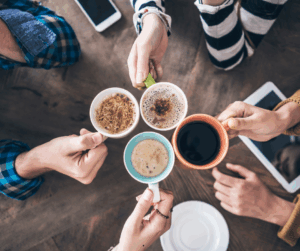
Fall Coffee Takeaway
Bottom line: your body is smart, but it’s also sensitive. Fall is for cozy indulgence, but also for strategic health choices. Every sip either helps or hinders the masterpiece that is your metabolism and hormones.
So, enjoy your pumpkin spice ritual, but make it one that supports your hormones, metabolism, and long-term health, not one that quietly undermines them. Because real comfort comes from feeling energized and toxin-free…not just smelling like autumn.


